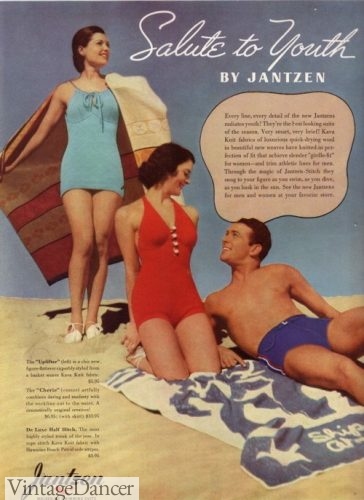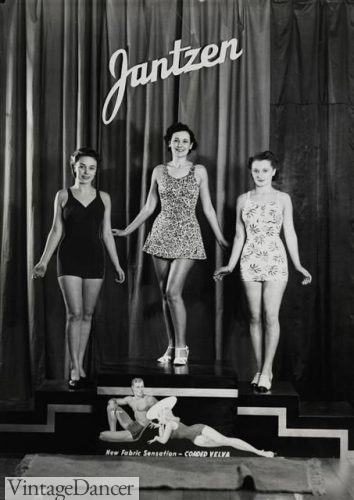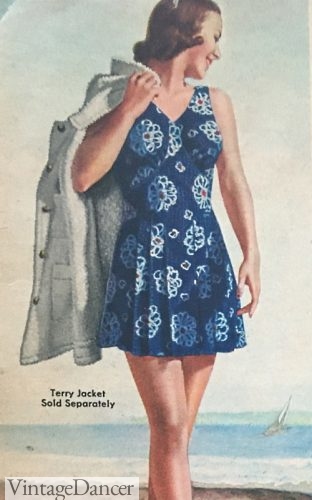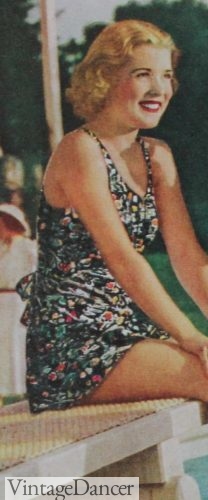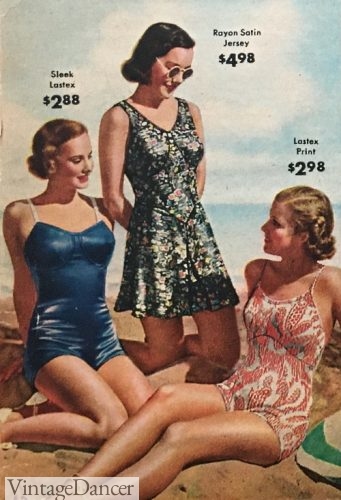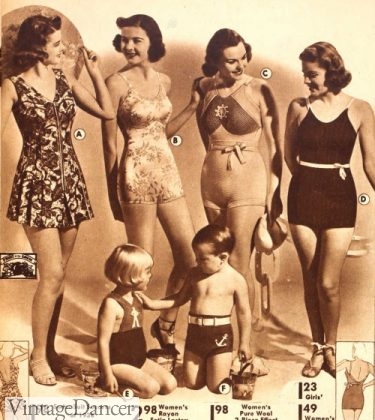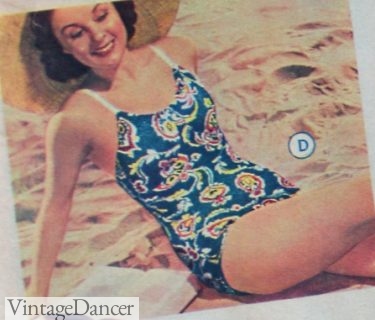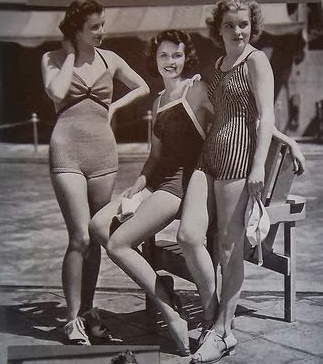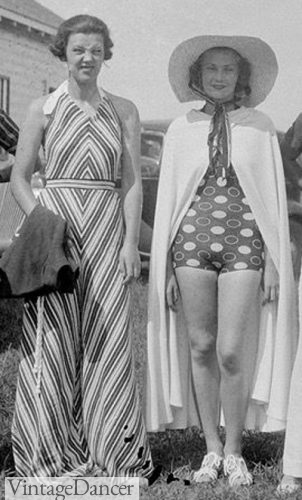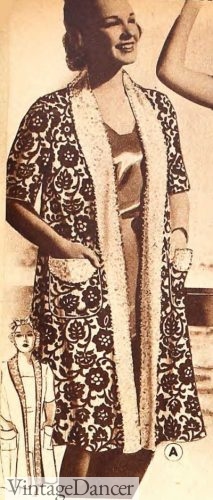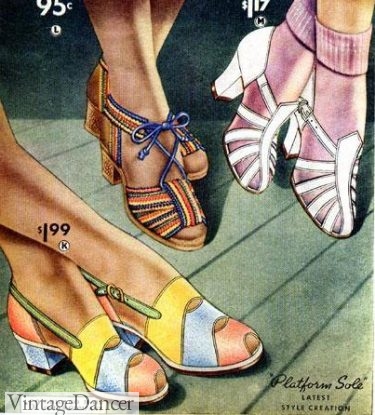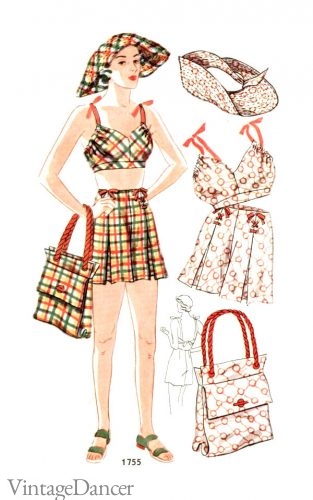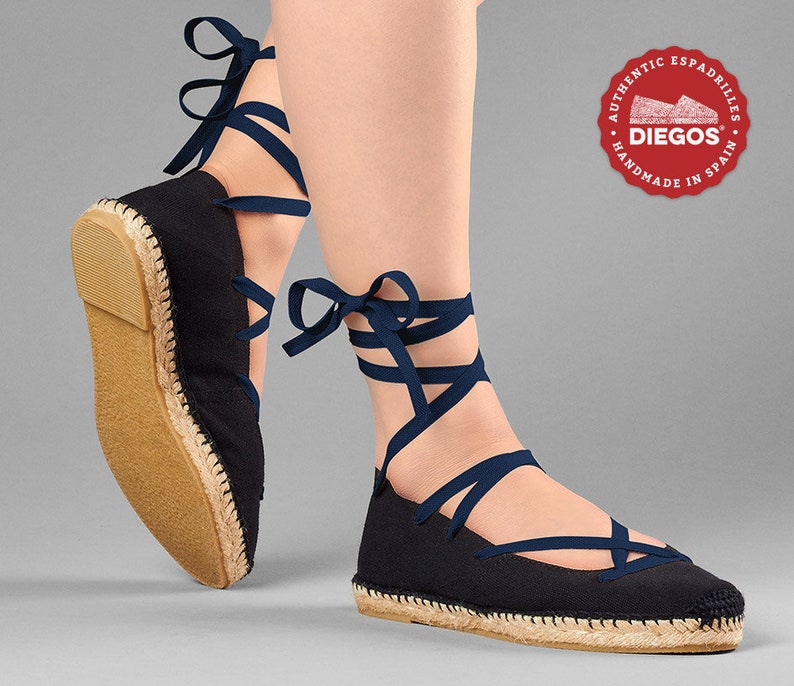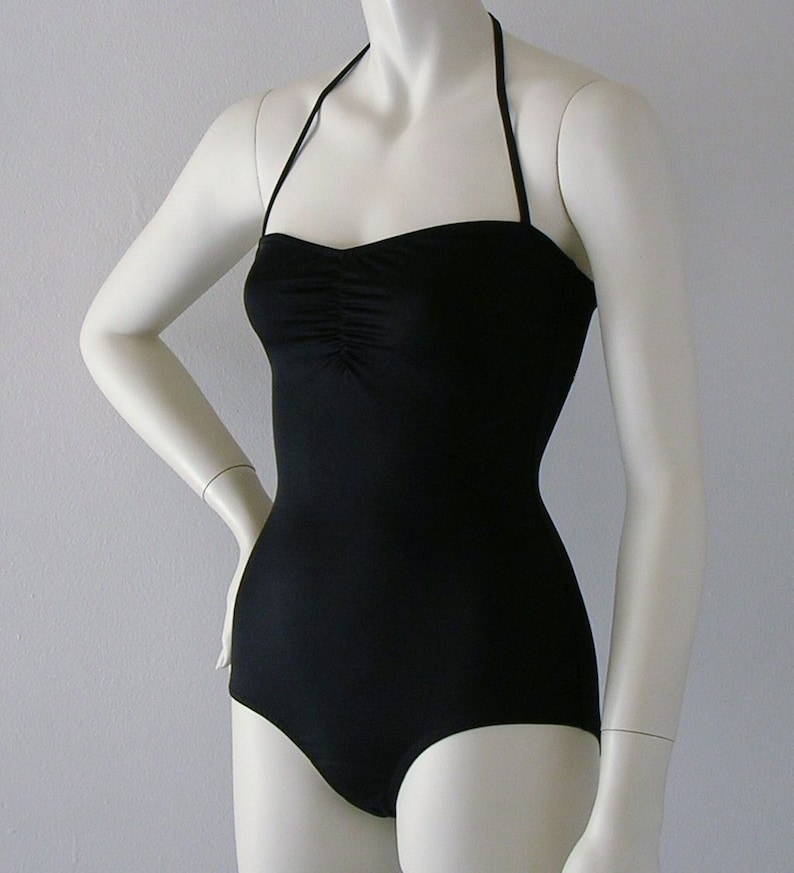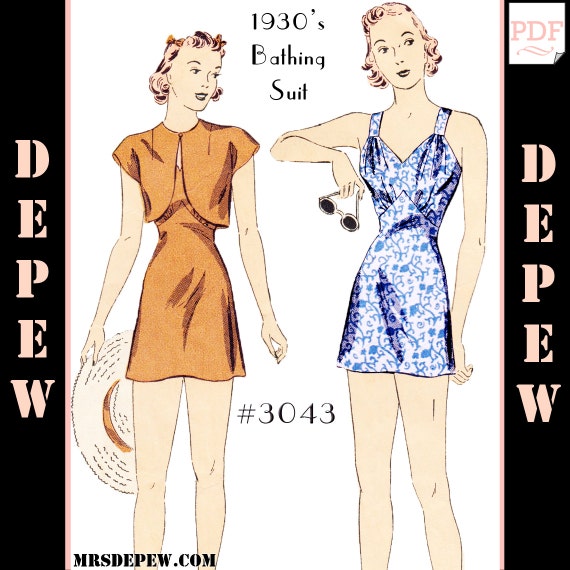While the 1920s started the trend for leisure activities like swimming, it was economic changes in the 1930s that made swimming a pastime for everyone — not just those lucky enough to live near a beach. The New Deal funded community pools to open up around the country. Cheap entry prices made swimming an affordable diversion for weekend fun.
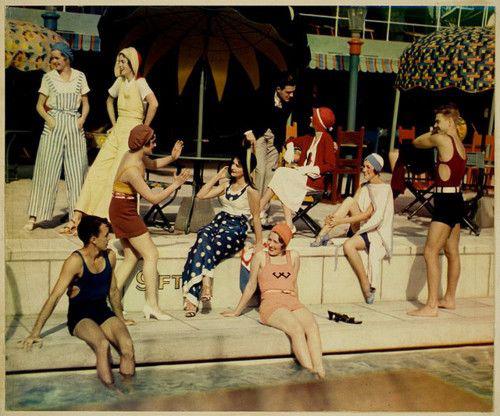
1930 swimwear and beach pajamas in color!
For the upper class, “vacationing” to beach-side resorts via passenger ships (who had pools on board) and air travel meant there was a now a need to look good while swimming, wading, or lounging by the water (many people who grew up away from natural water still did not know how to swim).
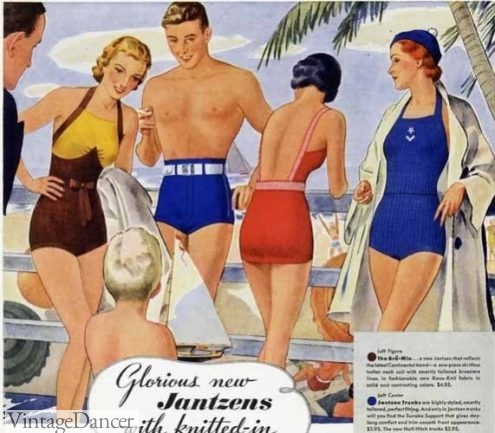
1935 swimwear
Yarn covered in rubber invented in 1931, Lastex, made swimwear much more comfortable and lighter to wear. Previously, all-wool swimsuits looked fine dry but sagged terribly when wet (and weighed a few extra pounds, too).
With less sag, thinner material, and a stiffer stretch to it, Lastex made it possible for designers to build in support for women — namely girdles and light bras. This helped women of all shapes look and feel better in swimwear. Lastex could be made of cotton or Rayon, which was also more comfortable against the skin than wool.
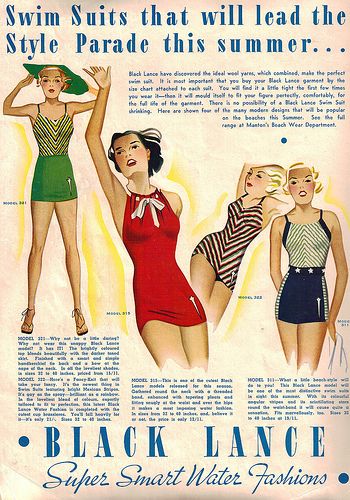
Ribbed wool, Zephyr silk-wool, worsted wool, and ribbed cotton were all still used through the 1930s. Rayon-satin jersey was the cheaper fabric to buy, although many women liked how shiny the fabric was. Most swimsuits were lined in a soft cotton jersey for comfort.
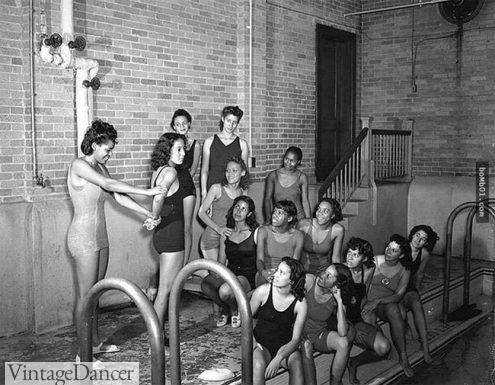
Lifeguards in training wearing wool swimsuits- Early 1930s
The silhouette of the 1930s swimsuit took on direct inspiration from men’s swimsuits (which were still one pieces). Men were encouraged to build a muscular yet lean sportsman’s body. Women also needed to slim down into an athletic body that was tall, lean, and curvy up top to flatter the latest bias cut dresses.
Bathing suits in the early 1930s changed little from the 1920s styles. Some now had striped tops like men’s swimwear had and others had much lower backs. Appliques of sea-life, anchors, and birds gave simple swimsuits some charm.
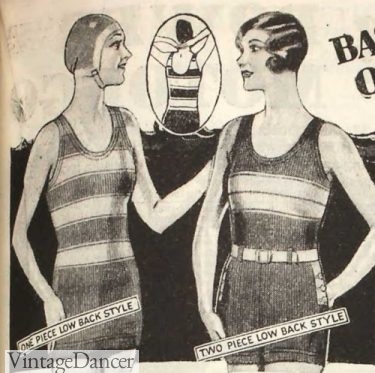
1931 men’s style swimsuits for women
1930s swimsuits were cut to show off more leg and more back skin than ever before. The thin straps also made the shoulders appear broader and more athletic. The new shape became what we know as the modern swimsuit today.
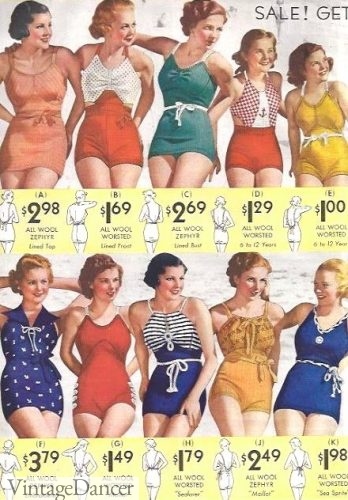
Early 1930s swimsuits
Designer Jean Patou made Cuban inspired minimalist color swimsuits and bathing suits his signature. Swimsuits were for athletic swimming while bathing suits were for lounging, with the latter having more support built in. In 1923, Patou invented a dyeing process that would not fade in the sun. This made it possible to introduce more colors as well as mixing colors on one suit.
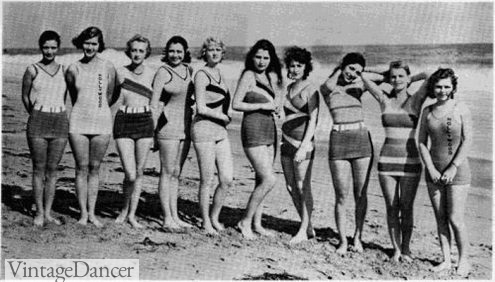
Cuban inspired designs
In the 1920s, most swimsuits were one solid color only. In the 1930s, a top half and bottom half could each be different colors or have cubist shapes stitched into (or onto) the design for even more color. Belts and decorative ties emphasized the waist. Darts and gathers were sewn in to give shape at the bust. A halter-neck helped lift the bust and expose the back. Swimwear was now real fashion.
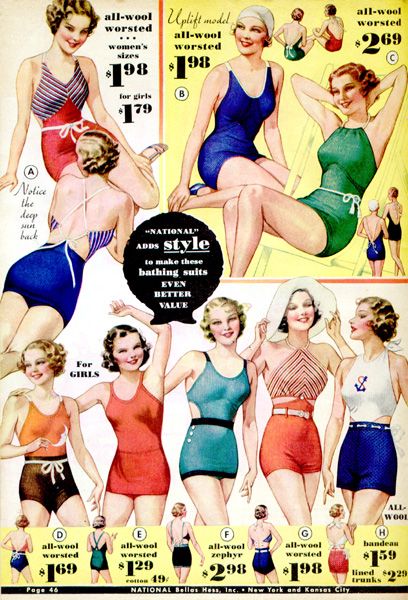
1934 colorful swimsuits
The biggest names in swimwear were Jantzen of Oregon, whose logo was a red diver; Catalina and Cole, both of Los Angeles, California; and B.V.D of Ohio. Each company used Lastex, a full spectrum of colors, and various degrees of support for their swimsuits. They each claimed to have their own special knitting technique and material blend that would shape a woman’s body, providing the same support as a bra and girdle. Once wet, they never fit as nice as their ads, no matter the technique.
- 1937 Jantzen Ad
- Late 1930s Jantzen swimwear made for corded velva
1930s Bathing Suit Styles
The three main styles of swimsuits in the 1930s were the skirted, the skirtless, and the dressmaker.
The skirted swimsuit was fitted at the torso with a short and tight skirt covering the crotch and buttocks. Fabric was cut on the bias / cross-wise to provide a good stretch across the body.
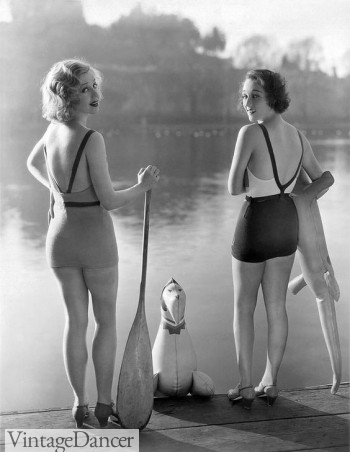
Adrienne Dore and Mae Madison 1935 in revealing strap back swimsuits in skirted maillot style
The mid 1930s saw a skirtless swimsuit that was a tank top style on top and a pair of “boy shorts” at the bottom half. This revealed a women’s crotch for the first time. They were easier to swim in for athletes and less likely to roll up in the water like skirted models did. They were especially popular when made of knitted cotton or wool and a looser fit. Of all the 1930s bathing suit styles, this is my favorite.
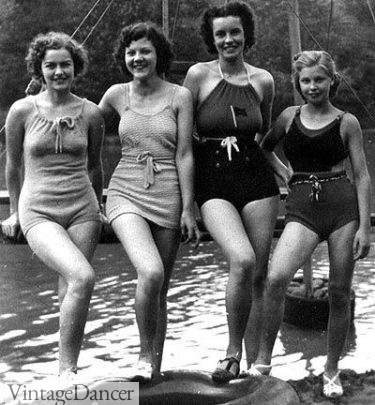
Coal Carnival beauty pageant 1937 swimsuits in both maillot and boy leg
The dressmaker was what we would call a swimdress today. It was less fitted and had a pleated or full A-line skirt that covered the hips and behind. The bra like top helped support busty women white the tie back waist defined her curves. It was a late 1930s invention and one that was very welcoming by women with imperfect bodies.
- 1938 swim dress or dress maker style
- 1938 floral swim dress with tie back waist
Where a 1930s woman lived determined an appropriate level of modesty. New York and France were the most skin revealing, while the middle of the United States remained the most covered up. For those willing to reveal more skin, a low dipped V or squared back opening was in vogue, just like on evening gowns.
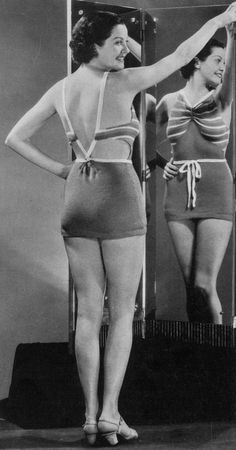
The crab back (X shape or Racerback today) was another option that revealed skin to tan, but was a little more modest. Swimsuit tops were still modest with a round, square, small V or halter neck that revealed skin but never cleavage.
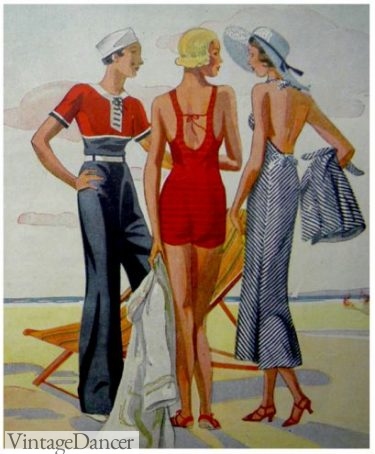
Crab back red swimsuit
The drawstring back straps and waist belt was one iconic style of the 1930s. The usually white corded drawstring made the straps as thin as could be while they tied around the front, making it possible for women to undo the string and remove the straps for the ultimate even suntan.
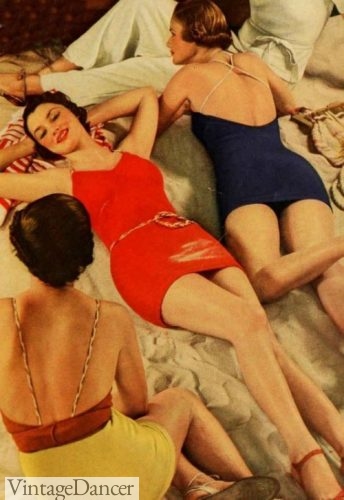
1934 robe back swimsuits
Going into the 1940s, the emphasis on the open back was wavering in favor of more bust. Necklines were lowered to just a hint of cleavage, with the sweetheart neck or V neck being the most helpful in this regard.
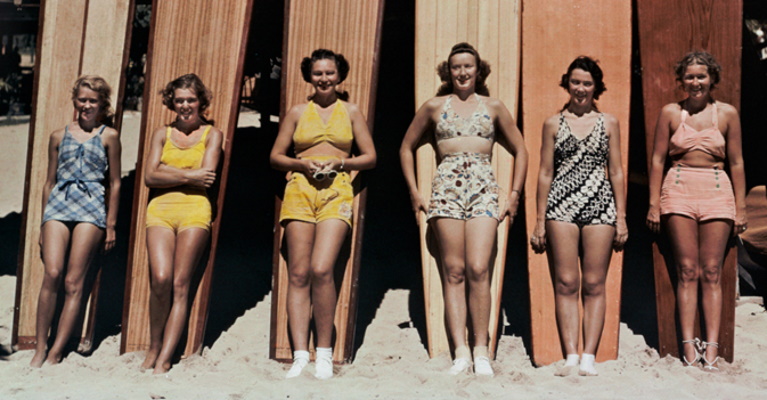
1937 surfers in Hawaii wearing new swimsuits and bikini suits
The beginnings of the first two piece Bikini were also on the horizon with just a piece of the sides of the swimsuit cut out to reveal some skin. The separated two piece suit came about in the late 1930s featuring a high waisted skirt or shorts and bra-like top. They were not yet mainstream but those with means had access to the new designer swimwear.
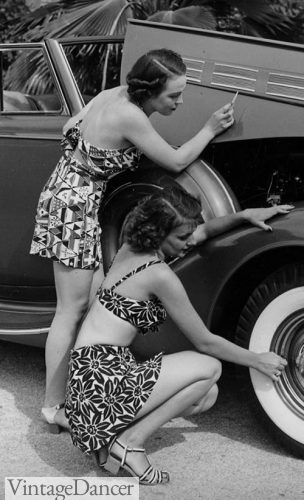
1937 the New bikini swimsuit- love those prints!
Big and small prints were also coming into style as inventions in materials continued to improve. All three styles of swimsuits remained trendy going into the 1940s. Read more about 1940s swimwear here.
- 1938 swimsuits
- 1938 swimwear varieties
- 1938 paisley print swimsuit
- 1939 Hollywood’s leading ladies show off the latest swimsuits
Watch this delightful video of 1930s swimsuits in color!
Bathing Suit Accessories
Coordinating beachwear accessories such as sunglasses, beach sandals, handbags, beach pajamas, sun hats, and terry cloth beach robes were not only practical but fashionable. A rubber swim cap and rubber water shoes were necessary for serious swimmers.
- Beach cape
- Beach robe -1938
- Sandals -1938 (Espadrille in Center)
- 1930s playsuit sets with matching beach bags

1935 Swim cap and water shoes
1930s Inspired Swimsuits
Sadly, not very many reproduction swimwear designers focus on 1930s swimsuits. Why not? I think they are adorable. This year, I have seen a few designers come out with some timeless vintage designs. Many of the 1950s style retro swimsuits can double for the 1930s, too, with a skirt effect (or boy shorts), modest top, and low back. Here are some of my favorites:
